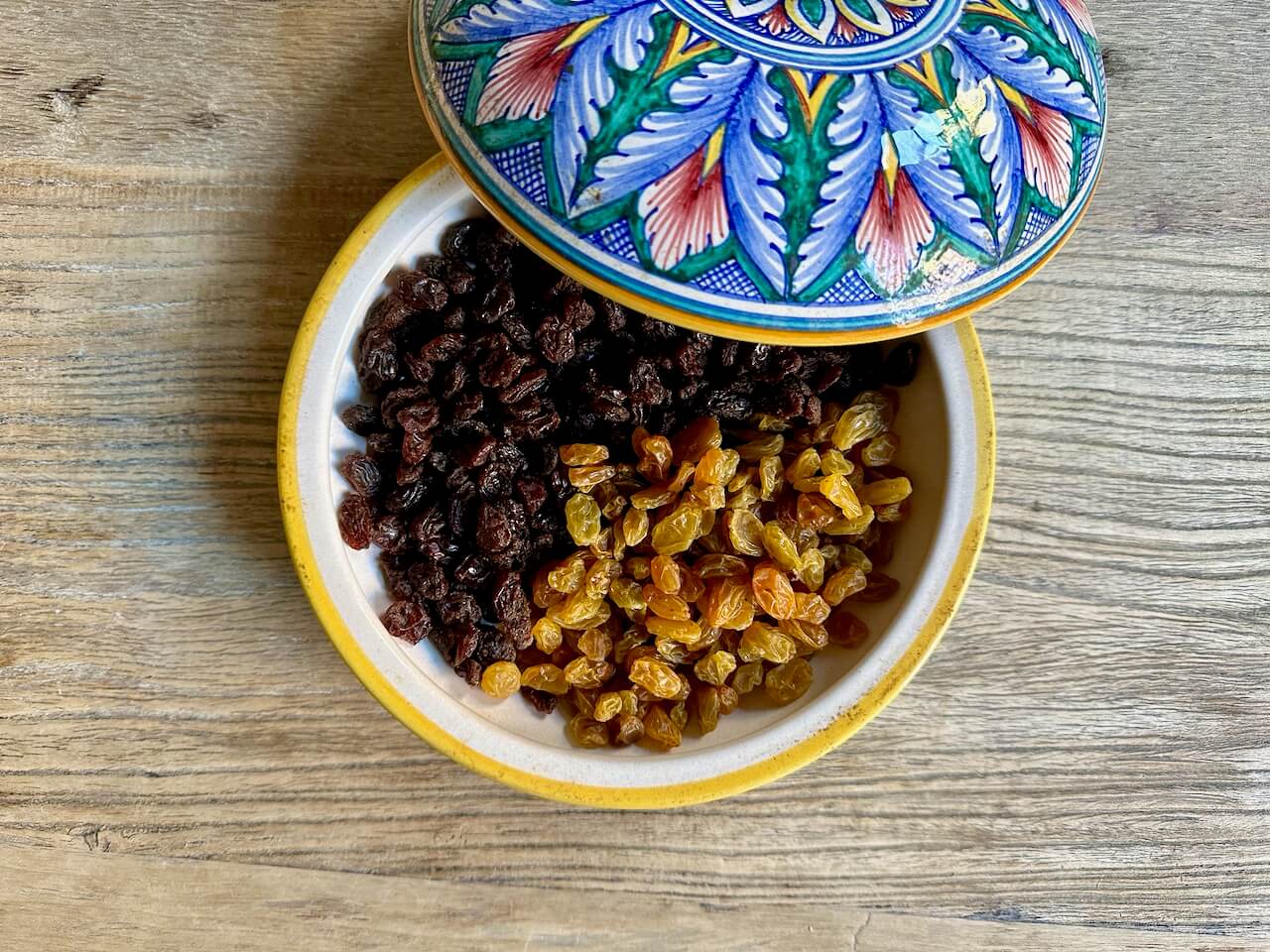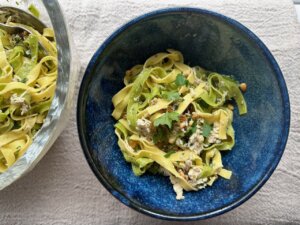Could this be the most underrated ingredient in all of Jewish cooking?
An ode to the sweet, compact and versatile raisin — plus a scrumptious recipe for tagliatelle with chicken, raisins and pignoli

Be it ever so humble, there’s no ingredient like raisins. Photo by Liza Schoenfein
The first thing that comes to mind when I think of raisins is small sticky fingers — my now-grown children’s, I suppose, though they might as well have been my own — prying one dark, shriveled nugget of sweet, gummy goodness after another from a tiny, bright-red Sun-Maid box into an equally sticky mouth. Those miniature cartons contained the perfect portable snack, offering cranky kids everywhere a boost of sugar-fueled energy as well as a conveniently distracting activity.
As a child and later a parent, I embraced raisins wholeheartedly. Like so many Jews of Central and Eastern European descent, I’ve enjoyed them in rice pudding, rugelach, noodle kugel and challah. If I could have done without them in my grandmother’s stuffed cabbage, I now know that sweet-and-sour is often an acquired taste.
It is also a common pairing in Jewish cuisines, particularly at Shabbat, having originated in the days before refrigeration when a sweet element would be added to foods preserved with vinegar to balance out the sharp acidity.
Once raisins made their way to Europe from the Levant in the 14th century, they became an integral part of Ashkenazi cooking.
“They were called rozhinke in Western Yiddish and vaymperlekh in Eastern Yiddish,” according to food historian Gil Marks in his Encyclopedia of Jewish Food. “If someone was disrespected,” he writes, “the typical response was ‘Iz mayn neshome den a rozshinke,’” meaning, “Is my soul a raisin?”
If the question alluded to the dark, shriveled nature of the fruit, it ignores the fact that raisins held a place of high honor in many Jewish celebrations. (They were often reserved for special occasions, because as an imported product they were relatively expensive.)
Sprinkling raisins and nuts over the groom during Shabbat services before an Ashkenazi wedding became a custom meant to encourage fertility and sweetness in the marriage.
Raisins are as prevalent in Sephardic and Mizrahi kitchens as they are in the Ashkenazic ones I grew up in and around. From Persian jeweled rice to North African stews to Venetian pastas and Levantine stuffed vegetables, raisins appear — often paired with walnuts or pine nuts — in countless dishes.
There are 32 recipes listed under “raisins” in The Jewish Cookbook, by Leah Koenig — including Ashkenazic favorites like baked apples and babka as well as dishes from the far reaches of the Diaspora such as malida, a sweetened porridge made by the Bene Israel Jews in India. The dish — “decorated with fresh and dried fruit, flowers, nuts, and coconut — is at the center of a ceremony originally created to honor the prophet Elijah. “The malida ceremony,” Koenig writes, “is held at births, engagements, graduations, or any other auspicious occasion.”
Claudia Roden’s classic The Book of Jewish Food also includes over 30 raisin dishes.
One is a regular go-to of mine: “Tagliatelle Frisinal,” or Tagliolini with roast chicken, raisins, and pine nuts. Roden explains that this was a typical Sabbath dish in the Venetian ghetto. Following the recipe is an illuminating section called “Jewish Italy,” in which Roden delves deep into the complex migratory and culinary history of Italy’s Jews. Raisins appear throughout, creating a kind of trail that winds its way from Sicily, Sardinia and Southern Italy, where Jews were banished, to the Central and Northern Italian cities in which they settled.
About the culinary style of Jews confined to the Venetian ghetto, Roden writes, “The coexistence in the ghetto bore fruit in the kitchen. The levantini brought riso pilaf and risi colle uette (rice with raisins, eaten cold, as in Istanbul today) … The Arab combination of pine nuts and raisins came both with the Sicilians and the levantini.”
Referring to the culinary legacy of Jews forced to convert or leave Spain during the Inquisition, Marks writes: “Raisins, along with nuts and oil, remain the signature ingredients of baking of the secret Jews, descendants of Conversos, most of whom do not know of their Jewish roots, of the American Southwest.”
Raisins even made it into wine. In places where Jews didn’t have access to fresh grapes — or when, as happened with the Conversos, the only wine available might be the sacramental wine of the Catholics — they created raisin wine from the dried fruit that was available to them.
“Although raisin wine is not the same as wine made from grapes,” according to Joan Nathan in Jewish Cooking in America, “it was one of the early methods of winemaking used by Jews throughout the world since the biblical period … From the eighth century onwards, Jews in Europe and the Middle East have made their own raisin wine for Passover.”
According to Nathan, we can thank raisin-wine-and mead-making Eastern European Jews, apparently, for bringing the idea of sweet kosher wine to these shores.
In Hebrew, the word for raisin is tzimuk — from the root “to shrivel.” But whether the stuff of nursery snacks, everyday dishes, or celebratory feasts — and shrivel though it surely does —it is most assuredly an ingredient that shines within the pantheon of iconic Jewish ingredients.
Tagliatelle with chicken, raisins, and pignoli

This recipe, inspired by Tagliatelle Frisinal from Claudia Roden’s The Book of Jewish Food, is a great way to use up leftover chicken — particularly from a store-bought rotisserie bird. It’s also a wonderful example of the prolific use of raisins paired with pine nuts in Sephardic kitchens. The sauce isn’t “saucy,” in that there’s hardly any liquid, especially once the pasta absorbs what little there is. This is the way the dish is intended, and it won’t be dry if you give it a quick toss with a splash of hot pasta water and some good extra-virgin olive oil at the end.
Serves 4
½ cup golden raisins
½ cup pignoli (pine) nuts
2 tablespoons olive oil
2 cloves garlic, minced
2 teaspoons chopped fresh rosemary or ½ teaspoon dried rosemary crushed between your palms to release the flavor
2 cups (about ½ pound) cooked shredded chicken (rotisserie works great here)
1 cup dry white wine, vermouth or chicken broth
¼–½ teaspoon salt, or to taste
Freshly grated black pepper to taste
½ cup fresh Italian (flat-leaf) parsley, roughly chopped, plus more for garnish
Extra-virgin olive oil for drizzling
1 pound tagliatelle or fettuccine, preferably fresh
- Bring a large pot of water to a boil and add at least a tablespoon of salt. If using dried pasta, add it now. If using fresh pasta, you will add it after Step 6.
- In a small bowl or a cup, soak raisins in warm water.
- Heat a large skillet over medium-low heat. Add the pignoli nuts and cook, shaking the pan periodically, until nuts are fragrant and lightly golden, about 2 minutes. Set nuts aside.
- Add olive oil to the pan and add garlic. Cook, stirring with a wooden spoon, for a minute or two, until garlic softens. (If it becomes pale golden that’s fine, but make sure not to let it get dark or it will be bitter. Move off the heat if necessary.)
- Drain and add raisins, along with the rosemary, and cook, continuing to stir, for 1–2 minutes.
- Raise heat to medium-high. Add chicken, then wine or other liquid, and simmer gently, scraping up anything that’s stuck to the bottom of the pan so it becomes part of the sauce.
- If using fresh pasta, add it to the salted boiling water now, and cook according to package directions. Set a timer, and drain when pasta is ready — reserving about a quarter cup of the water in a bowl or cup — and transfer to a large serving bowl. (Cover it loosely if sauce isn’t ready.)
- When liquid has reduced slightly, turn off the heat. Add salt, pepper, parsley, and reserved pignolis and toss to combine.
- Pour chicken-raisin sauce over the pasta and drizzle with a bit of the reserved pasta water to loosen things up, along with a little extra-virgin olive oil, and toss. Taste for seasoning, adding more salt, pepper, water and olive oil if desired. Serve immediately.






















